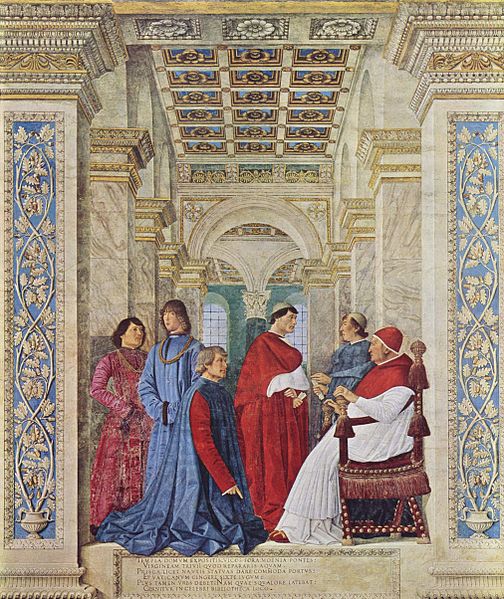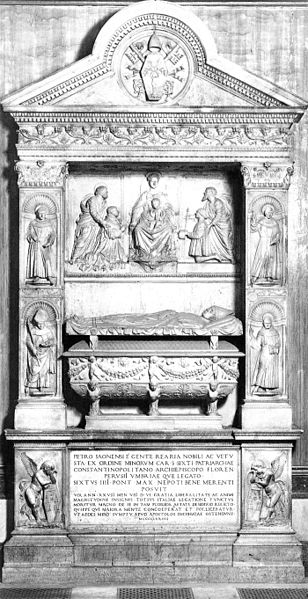 |
| Girolamo Riario (2nd L) Sixtus VI (R) |
A Betrothal
Christmas 1472
was an elaborate affair at the Milanese court. Everyone was treated to a new
wardrobe and hundreds of yards of red and black velvet were used to create
clothing decorated with gold or silver brocade. On Christmas Eve the court
assembled with their guests who included Ludovico Gonzaga, Marquis of Mantua, Pino Ordelaffi[i], Lord of Forli, Giovanni Bentivoglio, ruler of Bologna and Girolamo
Riario. Girolamo was
the son of Paolo Riario[ii]
and Bianca della Rovere, sister of the pope.
Girolamo’s
uncle had made him Captain General of the Church the year before. Girolamo was poorly
educated and had
spent much of his life selling fruit on street corners before his uncle was
elected pope. Girolamo was habitually over-dressed
in gold or silver brocade studded with jewels.
Galeazzo
Maria planned a marriage between one of his cousins, eleven year old Constanza
Fogliani[iii], and Girolamo to strengthen his ties
to the pope and increase his powerbase. Girolamo’s demand that he have sexual
relations immediately after the engagement was refused by Constanza’s mother[iv], something which surprised Galeazzo
Maria. He wrote to his ambassador in Rome;
‘To tell the truth,
Lady Gabriella seems strange and wild to us. We have been considerate of her
because she is a woman and, this being the nature of women, we don’t want to
argue with them.’[v]
Attempts
to persuade Girolamo failed and he threatened to depart without agreeing to the
marriage. Desperate to retain the pope’s favour[vi] Galeazzo Maria then proposed that
Girolamo marry his ten year old daughter Caterina. On 17th January
1473 Girolamo accepted the offer and the wedding contract was agreed in a
ceremony with only Galeazzo Maria, Bona and the court doctor in attendance.
Marriage
In
February Girolamo gave Caterina gifts including ‘two dresses of brocade and
velvet, three pearl necklaces, a pair of jewelled thimbles and a momentously
tasteless jewel ‘in the shape of a peasant’ with a pearl for a head.’ That
Girolamo slept with the ten year old Caterina was made quite clear by another
letter from her proud father to his ambassador;
 |
| Tomb of Cardinal Pietro Riario |
‘Count Girolamo
leaves this morning from here to return to His Holiness the Pope…..he slept
with his wife another time and he is very happy and content.’[vii]
The
new husband left his wife with her relatives in Milan. The pope felt forced to
issue a papal bull to sort out the irregularities in
the marriage, absolving his nephew of illegal intercourse and declaring the
last minute switch in brides valid.
Given
the haste of the arrangements minor matters such as Caterina’s dowry were dealt
with after the wedding. Galeazzo Maria gave Caterina a dowry of 10,000 ducats[viii] which Sixtus insisted be augmented
by the addition of Imola. Galeazzo Maria consented on the understanding that
Imola should be passed on to Girolamo’s heir. Sixtus paid Galeazzo Maria 40,000
ducats[ix] to make his nephew Lord of Imola[x]. The deal was sealed by Cardinal Pietro Riario, Girolamo’s younger brother.
On
3rd January 1474 Girolamo’s brother Pietro died at the age of
twenty-eight leaving his uncle ‘heart-broken’. Rumour had it that he had been
poisoned by the Venetians, but it is possible that his years of overindulgence
caught up with him. His rapidly accrued vast wealth was left to his brother.
Death of a Father
 |
| Murder of Galeazzo Maria Sforza |
Duke
Galeazzo Maria became increasingly unpopular with his subjects as a result of
his extravagance which not unnaturally coincided with increased taxes[xi],
and his behaviour which became increasingly cruel and bizarre. In December 1476
he and his family returned to Milan to celebrate Christmas; Bona begged Galeazzo
Mari not to attend the service at Sant Stefano’s on Christmas Day, claiming to
have dreamt of his murdered body.
Arriving at
the church Galeazzo Maria found three courtiers among the congregation waiting
for him to arrive; Carlo Visconti[xii], Gerolamo Olgiati[xiii] and Giovanni Andrea Lampugnani[xiv]. The three, along with their
henchman surrounded Galeazzo Maria and Lampugnani slammed a dagger into
Galeazzo’s torso and then his throat.
‘A scene of indescribable
violence then ensued.’[xv]
Members of
the duke’s entourage were killed and women had their jewellery ripped from
their persons. Lampugnani attempted to hide among the congregation pretending
to be a woman; he was ripped to pieces and fed to the pigs. Eleven of the
conspirators were rounded up by the ducal guard and their remains strung up on
the ramparts of the city. Several days later Visconti and Olgiati were
apprehended. Visconti claimed;
 |
| Bona of Savoy |
‘Were I to be reborn ten
times, and ten times to perish in these torments, I would give my blood and all
my strength for this sacred end.’[xvi]
Galeazzo
Maria’s will left his wife Bona as the regent for their seven year old son Gian
Galeazzo The real work of governing the dukedom fell to Cicco Simonetta[xvii] who saw the regent and the new duke
through the perilous aftermath of the assassination.
Galeazzo
Maria’s brother Ludovico[xviii] believed that it should be he, not
Bona who should act as regent to his nephew. He was able to make his move after
Bona set up a favourite, Antonio Tassino a low born gambler. Having divided
Bona from Simonetta by persuading her that he was acting against her best
interests, Ludovico claimed that Bona was having an affair with Tassino. Bona
went into exile and Ludovico took over the reins of government.
Family Affairs
 |
| Campo de' Fiori |
In April
1477, now fourteen, Caterina was formally married in Milan to Girolamo in a
proxy private ceremony. She had spent the years apart from her husband in
continuing her education and she learnt to play palla which was all the rage amongst the
Milanese aristocracy[xix].
The couple did not communicate in the time apart and during that period Girolamo
had produced an illegitimate son Scipione,
In May Caterina
travelled to Rome. On 26th May Caterina was presented to the pope
who decided to preside over a second wedding service which he promptly did. The
ceremony was followed by a banquet for two hundred of the couple’s closest friends at the Orsini palace in Campo de’ Fiori. The pope was quite clearly overjoyed by the alliance and
gave Caterina;
‘So many caresses that it
appears to us that her Ladyship is so well beloved by His Holiness that he
makes no difference between her and my Lord the Count [Girolamo].’[xx]
In
March 1478 Caterina bore her first child, Bianca[xxi] in Rome.
Ottaviano[xxii] was born just over a year later on
31st August 1479. Early in the year Girolamo bought a palazzo for
his family, situated behind the Piazza Navona. With his taste for conspicuous consumption Girolamo
hired the papal court painter Melozzo da Forli to create the murals which were de rigeur.
Bibliography
Italian
Dynasties – Edward Burman, Equation 1989
The Deadly
Sisterhood – Leonie Frieda, Harper Collins 2013
Tigress of
Forli – Elizabeth Lev, Head of Zeus Ltd, 2012
The Families
Who Made Rome – Anthony Majanlahti, Pimlico 2006
Absolute
Monarchs – John Julius Norwich, Random House 2011
Niccolo’s
Smile – Maurizio Viroli, IB Tauris & Co Ltd 2001
www.wikipedia.en
[i]
A condottiere
[ii]
A shoemaker
[iii]
The daughter of Galeazzo Maria’s uncle Corrado Fogliani , Marchese de Vighizzola, and
Gabriella Gonzaga, the illegitimate daughter of Ludovico Gonzaga.
[iv]
Normal practise was to wait until the legal age of consummation - fourteen
[v]
Tigress of Forli - Lev
[vi]
The Holy Roman Emperor had refused to confirm Galeazzo Maria as Duke of Milan
[vii]
Tigress of Forli - Lev
[viii]
In 2016
the relative: historic standard of living value of that income or wealth is £7,741,000.00, labour earnings of that income or wealth is
£63,920,000.00, economic status value of that income or wealth is £198,500,000.00, economic power value of that income or
wealth is £5,104,000,000.00 www.measuringworth.com
[ix]
In 2016
the relative: historic standard of living value of that income or wealth is £30,960,000.00, labour earnings of that income or wealth is
£255,700,000.00, economic status value of that income or wealth is £794,100,000.00, economic power value of that income or
wealth is £20,420,000,000.00 www.measuringworth.com
[x]
Galeazzo Maria had been negotiating with Lorenzo de’ Medici who had offered
100,000 ducats for the town
[xi]
One year Galeazzo Maria spent 40,000 ducats solely on jewels
[xii]
A member of the powerful Visconti family from
whom the dukedom had been seized by Francesco Sforza. Carlo was a secretary in
the Milanese Council of Justice
[xiii]
A supporter of Cola Montano who had been publicly whipped for lampooning
Galeazzo Maria; it was Montano who proposed assassinating the duke
[xiv]
Whose family had been involved in a dispute over land in which Galeazzo Maria
had refused to support them
[xv]
The Deadly Sisterhood - Frieda
[xvi]
Ibid
[xvii]
A former secretary to Francesco Sforza
[xix]
Galeazzo Maria set up an indoor palla court in the castle
[xx]
The Deadly Sisterhood - Frieda
[xxi]
Engaged to Astorre Manfreddi of Faenza
No comments:
Post a Comment
Note: only a member of this blog may post a comment.